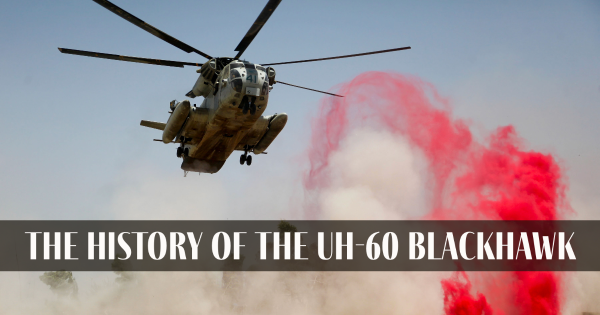Flight Ready: Making Certain Ideal Problem for Your UH 60 Helicopter
Flight Ready: Making Certain Ideal Problem for Your UH 60 Helicopter
Blog Article
Understanding the Mechanics and Design Behind Uh 60 Helicopters
The UH-60 helicopter, commonly recognized as the Black Hawk, stands as a peak of modern-day rotorcraft technology, personifying a mix of robust design and elaborate mechanics. From its creation to its present models, the development of this airplane showcases a fusion of development and functionality. As we peel off back the layers of the UH-60's design, a world of elaborate systems and careful engineering emerges. Understanding the technicians and design behind this flexible aircraft unveils a world where accuracy satisfies power, and where each element plays a crucial duty in achieving flight.
History of UH-60 Helicopters
The background of UH-60 helicopters traces back to the late 1970s when the United States Army looked for a versatile and innovative utility helicopter to change its aging fleet. In reaction to this demand, the Sikorsky Airplane Company established the UH-60 Black Hawk helicopter. Presented in 1979, the UH-60 quickly ended up being a staple in army procedures because of its remarkable capacities.
The UH-60 was created to master a selection of goals, including army transport, clinical emptying, digital war, and special operations. Its ability to adapt to various functions made it a beneficial property to the united state Military and various other military pressures all over the world
Over the years, the UH-60 platform has actually gone through several upgrades and variants to improve its efficiency and maintain pace with evolving objective requirements. These helicopters have seen considerable service in disputes such as the Gulf War, Afghanistan, and Iraq, showcasing their dependability and adaptability in varied operational settings. The UH-60's rich history is a testament to its enduring legacy as a leading energy helicopter.

Engine and Power Systems
Utilizing advanced propulsion modern technology, UH-60 helicopters are outfitted with sophisticated engine and power systems to guarantee ideal performance and integrity in a range of operational situations. The UH-60, generally recognized as the Black Hawk, is powered by two General Electric T700-GE-701D engines, each with the ability of supplying up to 1,940 shaft horsepower. These turboshaft engines provide the required drive for the helicopter to bring out its objectives efficiently, including army transport, medical emptying, and battle support.

Rotor System and The Rules Of Aerodynamics
Exactly how do the blades system and the rules of aerodynamics of UH-60 helicopters add to their operational performance and trip capabilities? The blades system of the UH-60 helicopter plays an important role in supplying lift and propulsion.
Aerodynamics additionally play an essential role in the performance of UH-60 helicopters. The structured fuselage and rotor blade design minimize drag, permitting the helicopter to accomplish greater speeds and far better fuel effectiveness. The aerodynamic layout of the UH-60 also adds to its capacity to run in diverse ecological problems, including high altitudes and warm temperature levels.
Avionics and Flight Control Solution

In its detailed control with the rotor system and aerodynamics of UH-60 helicopters, the avionics and trip control systems develop an important network of innovations shaping the airplane's operational capacities. In the UH-60, these systems include digital displays, interaction radios, GPS navigating, climate radar, and auto-pilot systems.
The trip control systems of the UH-60 are liable for equating the pilot's inputs into the proper adjustments to the rotor system, guaranteeing steady trip and maneuverability. These systems contain hydraulic actuators, this link servos, and computers that collaborate to control the tail and primary rotors, along with various other flight control surfaces. By precisely taking care of the helicopter's trip dynamics, these systems enable pilots to do a wide variety of goals, from transport and search-and-rescue to fight procedures, with accuracy and confidence.
Duty and Applications in Air Travel
The function and applications of avionics and flight control systems in aeronautics are important to making sure the risk-free and efficient procedure of airplane, including UH-60 helicopters. Avionics systems in UH-60 helicopters encompass a variety of digital systems that aid in navigation, interaction, monitoring, and managing different aircraft functions. These systems include electronic display screens, auto-pilot systems, interaction radios, GPS navigation equipment, and weather condition radar. Trip control systems play a vital role in maneuvering the helicopter in the air, keeping security, and guaranteeing specific movements. The fly-by-wire technology used in modern-day UH-60 helicopters equates pilot inputs into electronic signals, which are then translated by the flight control computer systems to change the airplane's control surface areas. Furthermore, these systems include security features such as autopilot settings, surface understanding alerting systems, and stability enhancement systems to boost the overall safety and functional capacities of the UH-60 helicopters in different goals, including troop transport, clinical evacuation, search and rescue, and airborne firefighting.
Conclusion
In final thought, the UH-60 helicopter is a functional aircraft with an abundant history and progressed engineering. Its engine and power systems, blades system, aerodynamics, avionics, and trip more helpful hints control systems all function together to make it a reputable and efficient device.
In its elaborate control with the rotor system and the rules of aerodynamics of UH-60 helicopters, the avionics and trip control systems develop a crucial network of technologies shaping the aircraft's functional abilities.The flight control systems of the UH-60 are responsible for converting the pilot's inputs into the appropriate adjustments to the rotor system, guaranteeing steady flight and maneuverability. Avionics systems in UH-60 helicopters include a range of digital systems that help in navigation, communication, surveillance, and controlling various airplane functions. Additionally, these systems include security attributes such as auto-pilot settings, surface awareness warning systems, and stability augmentation systems to boost the total security and functional capabilities of the UH-60 helicopters in various goals, consisting of troop transport, medical discharge, search and rescue, and aerial firefighting.
Its engine and visit this site power systems, blades system, aerodynamics, avionics, and trip control systems all function together to make it a reliable and reputable device.
Report this page